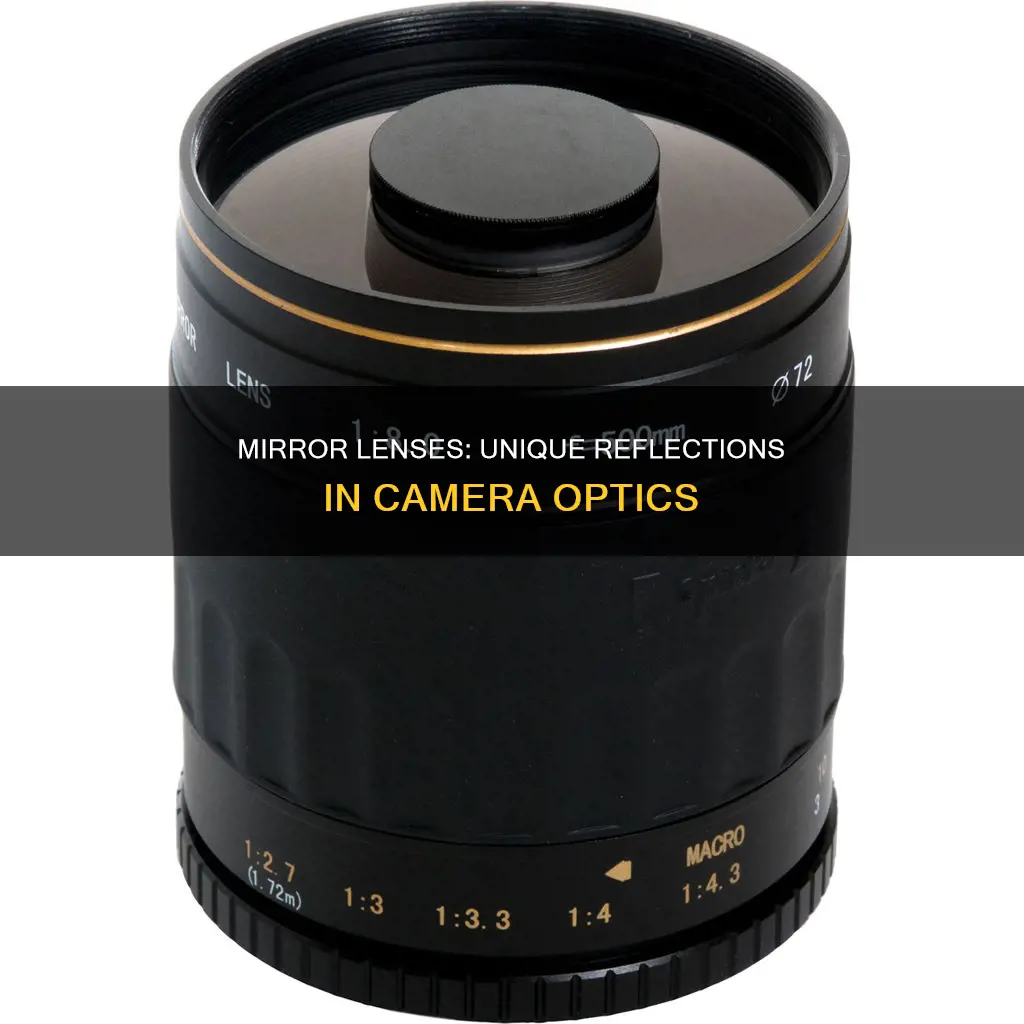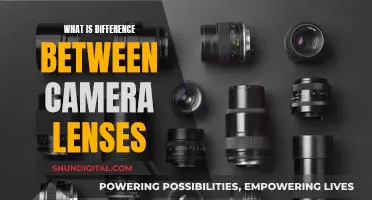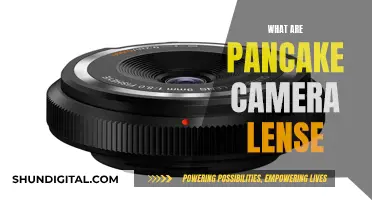
Mirrors and lenses are both used in optics and are essential components in fields such as photography, astronomy, microscopy, and vision correction. However, they differ in their construction, working, and the way they interact with light. Mirrors are devices based on the principle of reflection, while lenses are based on the principle of refraction. Mirrors reflect light falling on them, while lenses manipulate light. Mirrors have one side coated with a reflective material, usually a thin layer of metal, which allows for the reflection of light. Lenses, on the other hand, are transparent optical devices that refract (bend) and focus light rays. They are typically made of glass or transparent plastic and have curved surfaces. The differences in construction and working result in distinct characteristics and uses for mirrors and lenses.
What You'll Learn

Mirrors reflect light, lenses refract it
Mirrors and lenses are both optical instruments that manipulate and focus light, but they work in fundamentally different ways. The key difference is that mirrors reflect light, while lenses refract it.
Reflection
Mirrors are typically made of glass with one side polished to a smooth finish and coated with a thin layer of metal. This reflective surface bounces light off in the same direction and at the same angle that the light hits the mirror. The more polished or shiny the surface, the more light will bounce off it. This is why mirrors produce a clear image of the object reflecting off them.
Refraction
Lenses, on the other hand, are transparent optical devices that bend and focus light rays. They are usually made of glass or transparent plastic and have curved surfaces. When light rays fall on a lens, they change direction and speed as they pass from one medium to another, such as from air to glass. This bending of light is due to the difference in the refractive index of the two media.
Differences in Image Formation
The way mirrors and lenses form images is also distinct. Mirrors produce images by reflection, with light rays bouncing off the mirror's surface. A flat mirror produces a virtual image, while a curved mirror can produce a real or virtual image, depending on its shape and the position of the object.
Lenses form images through refraction. Convex lenses, which are thicker in the middle, bend light rays to a single focal point, creating real or virtual images. Concave lenses, on the other hand, are thicker at the edges and spread out light rays, resulting in virtual images.
Camera Lenses: Tax Benefits and What Qualifies as 'Listed Property
You may want to see also

Mirrors are one-sided, lenses have two surfaces
Mirrors and lenses are both optical instruments that manipulate and focus light, but they work in fundamentally different ways. Mirrors are one-sided, while lenses have two surfaces.
A mirror is an optical device, usually made of glass with a smooth reflective surface. One side of the mirror is polished with a thin layer of metal, allowing for the reflection of light. When light rays fall on a mirror, they get reflected from its surface at the same angle at which they hit it. This is the principle of reflection. The more polished or shiny the surface, the more light will "bounce off" it. Mirrors can be classified into plane mirrors, concave mirrors, and convex mirrors, each with different properties and uses.
On the other hand, a lens is a transparent optical device with two surfaces that refract (bend) and focus light rays. Lenses are typically made of glass or transparent plastic and can be curved or plane. The lens works on the principle of refraction, where light rays bend due to differences in the refractive index of the atmosphere and the material of the lens. Lenses come in different shapes and curvatures, which impact the image formed. There are two main types of lenses: convex and concave.
The key difference between mirrors and lenses is that mirrors operate based on the reflection of light, while lenses work through refraction. Mirrors are coated on one side, while lenses are transparent and have two sides that light passes through. This distinction makes mirrors and lenses unique and suited for different purposes, such as in photography, astronomy, microscopy, and vision correction.
In addition, mirrors produce images by reflection on only one surface, while lenses produce images by refraction on either of their two surfaces. The image formed by a mirror is always virtual, meaning it is not real and cannot be projected onto a screen. In contrast, lenses can produce both real and virtual images, depending on the type of lens and the position of the object.
Camera Kit Lenses: Worth the Money or Worthless?
You may want to see also

Mirrors have no focal point, lenses have two
Mirrors and lenses are both optical instruments that manipulate and focus light, but they work in different ways. Mirrors use reflection, while lenses use refraction. This fundamental difference also affects how they form images and how they are constructed.
Mirrors have a reflective surface, usually a thin layer of metal on glass or plastic, that reflects light without diffusion. A plane mirror, which is flat, produces an undistorted image. Curved mirrors, on the other hand, can distort, magnify, or reduce the image. Curved mirrors can be concave or convex. Concave mirrors have an inward curve and can produce real and upright, or virtual and inverted images, depending on the object's position. Convex mirrors have an outward curve and produce diminished, virtual, and upright images. Plane mirrors have no focal point, while concave and convex mirrors do.
Lenses, on the other hand, are transparent optical devices that refract (bend) and focus light. They are typically made of glass or transparent plastic and are curved. There are two main types of lenses: convex and concave. Convex lenses are thicker in the centre and converge light, while concave lenses are thinner in the centre and diverge light. Since light can pass through a lens in either direction, a lens has two focal points, one on each side.
Welding and Cameras: Can Welding Damage Camera Lenses?
You may want to see also

Lenses are simple or compound
Lenses are either simple or compound. A simple lens is a single lens that can magnify objects. A compound lens, on the other hand, is made up of multiple lenses (at least two) that work together to magnify objects.
A simple microscope, for example, is a basic magnifying instrument that uses a single lens to enlarge objects. It is typically used in situations where rigorous research is not required. Simple microscopes have a short focal length and a bi-convex lens, and can be used to examine small objects like jewellery, watch parts, or biological samples.
Compound microscopes, on the other hand, are used for professional purposes and in-depth research. They employ multiple lenses (usually 3 to 5) to provide higher levels of magnification. The total magnification of a compound microscope is the result of combining the magnifications of the objective lens and the eyepiece. This type of microscope is commonly used in pathology labs, forensic labs, and schools for academic experiments.
Lenses can also be classified as convex or concave. A convex lens is thicker in the centre and thinner at the edges, causing light rays to converge. Convex lenses are used in glasses, cameras, and telescopes. A concave lens, on the other hand, is thinner at the centre and thicker at the edges, causing light rays to diverge. Concave lenses are used in eyeglasses, flashlights, and telescopes.
The Evolution of Camera Lenses: Losing Sharpness Over Time?
You may want to see also

Mirrors are used in telescopes, lenses in eyeglasses
Mirrors and lenses are both optical instruments that manipulate and focus light, but they work in different ways. Mirrors reflect light, while lenses refract it. This fundamental difference has a significant impact on their characteristics and the way they are used.
Mirrors are optical devices that reflect light without diffusion, forming images through reflection. They are typically made of glass with a smooth, polished surface and a thin layer of reflective coating on one side, such as a metal like aluminium. When light rays fall on a mirror, they bounce off its surface at the same angle at which they approached, following the law of reflection. Plane mirrors, which are flat, produce undistorted images of the same size as the object. Concave mirrors, which curve inward, can produce real or virtual, upright or inverted images of varying sizes, depending on the position of the object. Convex mirrors, which curve outward, produce diminished, virtual, upright images.
Lenses, on the other hand, are transparent optical devices that bend and focus light through refraction. They are usually made of glass or transparent plastic and have curved surfaces. When light rays pass through a lens, they bend due to the difference in the refractive index of the atmosphere and the material of the lens. Lenses come in different shapes and sizes, which impact the image they produce. Convex lenses, thicker in the middle and thinner at the edges, converge light to form real or virtual images. Concave lenses, thinner in the middle and thicker at the edges, diverge light to create virtual images.
In the context of telescopes and eyeglasses, the differences between mirrors and lenses become particularly relevant. Telescopes can be of two types: reflecting telescopes (using mirrors) and refracting telescopes (using lenses). Reflecting telescopes use curved mirrors to gather and focus light from distant objects. Mirrors are preferred in telescopes because they are lighter, easier to manufacture, and can reflect all wavelengths of light, providing more detailed information. Additionally, large mirrors are simpler to fabricate than large lenses, as mirrors only require treatment on one side.
Eyeglasses, on the other hand, typically use lenses to correct refractive errors in vision. Concave lenses are commonly used in eyeglasses to correct hyperopia (farsightedness) by diverging light before it enters the eye, making it easier to focus. Convex lenses, which converge light, are used to correct myopia (nearsightedness).
Do Contact Lenses with Camera Exist?
You may want to see also
Frequently asked questions
Mirror lenses work on the principle of reflection, whereas other camera lenses work on the principle of refraction. Mirrors reflect light, while lenses refract (bend) it. Mirrors have one reflective surface, while lenses have two.
Mirrors are ideal for applications where a clear, undistorted image is required, such as personal grooming or photography. They also have the advantage of reflecting 100% of the light that falls on them.
Mirrors can only reflect light from one direction, while lenses can refract light from multiple directions. This makes lenses more versatile for applications such as photography, where the ability to capture light from different angles is important.
Mirror lenses are commonly used in telescopes, solar cookers, security applications, periscopes, torch lights, home décor, and cameras.







